

An encyclopedia of Middle-earth and Numenor

|
|
|
|
|
|
|
|
|
|
|
|
|
|
| |
|
 |

An encyclopedia of Middle-earth and Numenor |
 |
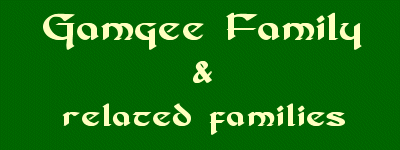
See the Gamgee family tree at the bottom of the page.
Genealogy:
See the Gamgee
family tree below.
Source:
Appendix
C of The Lord of the Rings: Gamgee genealogy, p. 383
Names &
Etymology:
The name Cotman means "cottager,
cot-dweller." His name in the Hobbits' language was Hlothram.
Genealogy:
See the Gamgee
family tree below.
Sources:
Appendix
C of The Lord of the Rings: Gamgee genealogy, p. 383
Appendix
E of The Lord of the Rings: "The Languages and Peoples of the Third
Age," p. 416
"Nomenclature
of The Lord of the Rings," entry for Cotton
Names &
Etymology:
Cottar is a Scottish term
for a cottager, or a peasant farmer living in a cottage.
Genealogy:
See the Gamgee
family tree below.
Source:
Appendix
C of The Lord of the Rings: Gamgee genealogy, p. 383
During the War of the Ring, the Shire was occupied by Men. On November 2, 3019, Sam Gamgee came to the Cotton farm to rally them to help expel the Men. Nick accompanied his father and brothers Tom and Jolly to the center of town where they drove off a band of about 20 Men. The next day on November 3, Nick fought in the Battle of Bywater in which the Men were defeated and driven from the Shire.
Names &
Etymology:
Bowman Cotton was usually
called
Nick Cotton.
Genealogy:
See the Gamgee
family tree below.
Sources:
The Return
of the King: "The Scouring of the Shire," p. 286-87, 294-95
Appendix
C of The Lord of the Rings: Gamgee genealogy, p. 383
Nibs and his siblings were friends with Sam Gamgee. They sometimes swam together in Bywater Pool. When Sam Gamgee returned to the Cotton farm after the quest to Mount Doom, Nibs didn't recognize him at first and challenged him with a pitchfork. He had been charged with protecting his mother and sister from the Men who had occupied the Shire. The next day on November 3, 3019, Nibs and his brothers fought in the Battle of Bywater in which the Men were defeated and were driven from the Shire.
Genealogy:
See the Gamgee
family tree below.
Sources:
The Return
of the King: "Mount Doom, " p. 216; "The Scouring of the Shire," p.
287, 294-95
Appendix
C of The Lord of the Rings: Gamgee genealogy, p. 383
Names &
Etymology:
Holman Cotton was known as
Long
Hom. The name Holman may imply "hole dweller."
Holman Cotton was the first of the family to use the surname Cotton. The name Cotton comes from cot meaning "cottage, humble dwelling" and ton meaning "town." It appears to be derived from his father's name Cotman which means "cottage dweller."
Genealogy:
See the Gamgee
family tree below.
Source:
Appendix
C of The Lord of the Rings: Gamgee genealogy, p. 383
"Nomenclature
of The Lord of the Rings," entry for Cotton
Lily Cotton's birth and death dates are not recorded.
Names &
Etymology:
Lily had a flower name like
many Hobbit women.
Genealogy:
See the Gamgee
family tree below.
Sources:
The Return
of the King: "The Scouring of the Shire," p. 287
Appendix
C of The Lord of the Rings: Gamgee genealogy, p. 383
Marigold married Tom Cotton, brother of Rosie Cotton. Rosie was Marigold's friend from childhood, and she married Marigold's brother Sam.
Names &
Etymology:
Marigold had a flower name
like many Hobbit-lasses. Her name was chosen because of her golden hair.
Genealogy:
See the Gamgee
family tree below.
Sources:
The Return
of the King: "Mount Doom," p. 211
Appendix
C of The Lord of the Rings: Gamgee genealogy, p. 383
"Nomenclature
of The Lord of the Rings," entry for Marigold
Farmer Tolman Cotton |
Farmer
Cotton in the New Line film
|
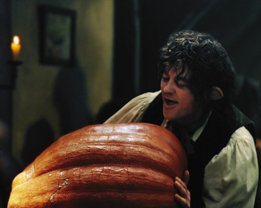 Farmer
of Bywater; father of Rose
Cotton Gamgee. Tolman Cotton was born in 2941 of the Third Age. His
nickame was Tom. His father was Holman Cotton
of Bywater; his mother's name is not known. Tom had a younger brother Wilcome,
called Will. Tom Cotton married Lily Brown and they
had five children:
Tolman (also called Tom),
Rose, Wilcome (called Jolly),
Bowman(called
Nick), and Carl (called Nibs).
Farmer
of Bywater; father of Rose
Cotton Gamgee. Tolman Cotton was born in 2941 of the Third Age. His
nickame was Tom. His father was Holman Cotton
of Bywater; his mother's name is not known. Tom had a younger brother Wilcome,
called Will. Tom Cotton married Lily Brown and they
had five children:
Tolman (also called Tom),
Rose, Wilcome (called Jolly),
Bowman(called
Nick), and Carl (called Nibs).
Tom Cotton was generally known as Farmer Cotton. He had a farm down the South Lane in Bywater. Farmer Cotton was considered a stout and sturdy fellow. He was a person of high standing in Bywater.
During the War of the Ring, Farmer Cotton wanted to oppose the Chief's Men who had taken over the Shire, but he was unable to convince enough Hobbits to rise against them. He protected his wife and daughter from the Men and he gave extra food to Gaffer Gamgee, father of Sam Gamgee.
On November 2, 3019, Sam came to Farmer Cotton's farm and told him that he had returned with Frodo Baggins, Merry Brandybuck, and Pippin Took and that they were rallying the Hobbits to drive out the Chief's Men. Farmer Cotton took his sons Tom, Jolly, and Nick into Bywater to join the fight. Farmer Cotton provided information on the numbers and strengths of the Men and explained what had been happening in the Shire over the past year. When a squad of 20 Men arrived in Bywater, Farmer Cotton stood alone in the street to confront them while the other Hobbits quietly surrounded them. The Men's leader was killed and the others surrendered.
The next day on November 3, Farmer Cotton and his sons fought in the Battle of Bywater, and the Chief's Men were defeated and driven out of the Shire for good. Afterwards, Farmer Cotton led an escort of two dozen Hobbits who accompanied Frodo to Bag End to confront the Chief.
Frodo and Sam stayed with Farmer Cotton while Bag End and Bagshot Row were being repaired. Farmer Cotton discovered Frodo lying ill and delirious in his bed on March 13, 3020 - the anniversary of Frodo's poisoning by Shelob.
The fame and fortune of the Cotton family rose considerably after the War of the Ring. Farmer Cotton's daughter Rosie married Sam Gamgee, who later became Mayor of Michel Delving and moved into Bag End. Farmer Cotton died in the year 19 of the Fourth Age.
Names &
Etymology:
The name Cotton comes from
cot
meaning "cottage, humble dwelling" and ton meaning "town."
Genealogy:
See the Gamgee
family tree below.
Sources:
The Return
of the King: "The Scouring of the Shire," p. 286-300; "The Grey Havens,"
p. 304
Appendix
C of The Lord of the Rings: Gamgee genealogy, p. 383
"Nomenclature
of The Lord of the Rings," entry for Cotton
Tom Cotton lived on his father's farm in Bywater. Tom and his siblings were friends with Sam Gamgee and they swam together in Bywater Pool.
During the War of the Ring, the Shire was occupied by Men in the service of Saruman. Tom and his brothers helped their father protect their farm and their mother and sister. On November 2, 3019, Sam Gamgee returned to the Shire and came to the Cotton's farm seeking their help to evict the Men. Tom, Jolly, Nick, and their father went to the center of town where many other Hobbits were assembling, and they drove off a squad of Men who came to confront them. The next day on November 3, Tom fought in the Battle of Bywater which ended in victory for the Hobbits.
After the war, the Cotton family became even more prosperous. Tom was married to Sam's sister Marigold, and Sam married Tom's sister Rosie. In the year 21 of the Fourth Age, Tom Cotton acted as Deputy Mayor while Mayor Sam Gamgee travelled to Gondor.
Names &
Etymology:
Tom Cotton was sometimes
called Young Tom to distinguish him from his father, for whom he
was named. The name Cotton comes from
cot meaning "cottage,
humble dwelling" and ton meaning "town."
Genealogy:
See the Gamgee
family tree below.
Sources:
The Return
of the King: "Mount Doom, " p. 216; "The Scouring of the Shire," p.
286-87, 293
Appendix
B of The Lord of the Rings: "The Tale of Years," p. 378
Appendix
C of The Lord of the Rings: Gamgee genealogy, p. 383
"Nomenclature
of The Lord of the Rings," entry for Cotton
Jolly Cotton lived on the family farm in Bywater. He was friends with Sam Gamgee and they used to swim in Bywater Pool together. Sam later married Jolly's sister Rosie.
When the Shire was occupied by Men during the War of the Ring, Jolly helped defend the farm and keep his mother and sister safe. Sam returned to Bywater on November 2 and Jolly showed him where to find his father the Gaffer, who had been relocated from Bagshot Row. On November 3, Jolly fought in the Battle of Bywater in which the Hobbits defeated the Men and drove them out of the Shire.
Names &
Etymology:
Wilcome was named after his
father's brother. He was probably called Jolly
because of his demeanor.
Genealogy:
See the Gamgee
family tree below.
Sources:
The Return
of the King: "Mount Doom, " p. 216; "The Scouring of the Shire," p.
286-87, 291, 294-95
Appendix
C of The Lord of the Rings: Gamgee genealogy, p. 383
Names &
Etymology:
Wilcome Cotton was called Will for
short.
Genealogy:
See the Gamgee
family tree below.
Source:
Appendix
C of The Lord of the Rings: Gamgee genealogy, p. 383
Elanor the Fair |
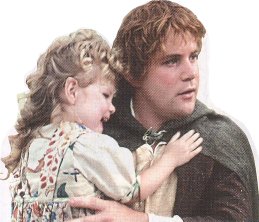 Daughter
of Sam Gamgee. Elanor Gamgee was born on March 25,
3021 of the Third Age, on the anniversary of the destruction of the One
Ring and the downfall of Sauron. She was
the eldest child of Sam and
Rose Cotton Gamgee.
Daughter
of Sam Gamgee. Elanor Gamgee was born on March 25,
3021 of the Third Age, on the anniversary of the destruction of the One
Ring and the downfall of Sauron. She was
the eldest child of Sam and
Rose Cotton Gamgee.
Sam asked the advice of Frodo Baggins in choosing a name for his daughter. It was Frodo who suggested that she be named after the golden flower elanor found in Lothlorien, thus following the Hobbit custom of naming girls after flowers while selecting a unique name that suited the beautiful, golden-haired child. In later years she came to be called Elanor the Fair. In appearance, some said she was more like an Elf-maid than a Hobbit.
Elanor became a maid of honor to Queen Arwen when the Queen and Aragorn, King Elessar, came to the North-kingdom in the year 15 of the Fourth Age. In the year 21, Elanor accompanied her parents to Gondor and stayed there for a year. Elanor married Fastred of Greenholm in 30. Fastred was made Warden of Westmarch in 34, and he and Elanor made their home at Undertowers on the Tower Hills in the Westmarch. Elanor and Fastred's descendants came to be known as the Fairbairns of the Towers. Their son Elfstan Fairbairn was born in 33. They also had a daughter named Firiel.
In September of 61, Sam Gamgee visited his daughter at Undertowers for the last time. He gave her the book chronicling the finding and the destruction of the One Ring that had been written by Bilbo and Frodo Baggins and finished by himself. That book came to be known as the Red Book of Westmarch and it was preserved by generations of Fairbairns. Elanor said goodbye to her father, who then went to the Grey Havens and passed over the Sea.
Names &
Etymology:
Elanor was named after the
golden flower of Lothlorien. The word elanor is composed of el
meaning "star" and anor meaning "sun."
She may also have been called Elanor Gardner after her father, who became known as Sam Gardner because of his skill at gardening and his role in replanting the Shire after the War of the Ring.
Genealogy:
See the Gamgee
family tree below.
Sources:
The Fellowship
of the Ring: "Prologue: Note on the Shire Records," p. 23
The Return
of the King: "The Grey Havens," p. 306
Appendix
B of The Lord of the Rings: "The Tale of Years," p. 377-78
Appendix
C of The Lord of the Rings:
Gamgee genealogy, p. 383
"The Adventures
of Tom Bombadil" in The Tolkien Reader: Preface, p. 192-93 and note
2
Names &
Etymology:
Erling is a Nordic name meaning
"heir of the clan chief" or "prince."
Genealogy:
See the Gamgee
family tree below.
Source:
Appendix
C of The Lord of the Rings: Gamgee genealogy, p. 383
Names &
Etymology:
Elfstan means "Elfstone,"
the Common Speech equivalent of "Elessar." It seems likely that Elfstan
was named in honor of Aragorn, King Elessar.
Genealogy:
See the Gamgee
family tree below.
Sources:
The Fellowship
of the Ring: "Prologue: Note on the Shire Records," p. 23
Appendix
B of The Lord of the Rings: "The Tale of Years," p. 378
Appendix
C of The Lord of the Rings: Gamgee genealogy, p. 383
"The Adventures
of Tom Bombadil" in The Tolkien Reader: Preface, 192-93 and
note 2
Names &
Etymology:
Fíriel is from the
Quenya meaning "mortal woman." Firiel Fairbairn may have been named for
a character in a poem called "The Last Ship" found in the Red
Book of Westmarch. The Firiel of the poem may have in turn been
named for a princess of Gondor who was an ancestor
of Aragorn.
Genealogy:
See the Gamgee
family tree below.
Source:
"The Adventures
of Tom Bombadil" in The Tolkien Reader: Preface, 192-93 and
note 2
Names &
Etymology:
Fastred is from the Anglo
Saxon fæstræd meaning "firmly resolved, steadfast."
Genealogy:
See the Gamgee
family tree below.
Sources:
Appendix
B of The Lord of the Rings: "The Tale of Years," p. 378
Beowulf Glossary
Genealogy:
See the Gamgee
family tree below.
Source:
Appendix
C of The Lord of the Rings: Gamgee genealogy, p. 383
Names &
Etymology:
Bilbo was named after Bilbo
Baggins.
He may also have been called Bilbo Gardner after his father, who became known as Sam Gardner because of his skill at gardening and his role in replanting the Shire after the War of the Ring.
Genealogy:
See the Gamgee
family tree below.
Source:
Appendix
C of The Lord of the Rings: Gamgee genealogy, p. 383
Genealogy:
See the Gamgee
family tree below.
Source:
Appendix
C of The Lord of the Rings: Gamgee genealogy, p. 383
Names &
Etymology:
Daisy was probably named after her
aunt, Sam's sister Daisy Gamgee. Like many Hobbit-lasses,
she had a flower name.
She may also have been called Daisy Gardner after her father, who became known as Sam Gardner because of his skill at gardening and his role in replanting the Shire after the War of the Ring.
Genealogy:
See the Gamgee
family tree below.
Source:
Appendix
C of The Lord of the Rings: Gamgee genealogy, p. 383
Genealogy:
See the Gamgee
family tree below.
Sources:
The Fellowship
of the Ring: "The Shadow of the Past," p. 53-54
Appendix
C of The Lord of the Rings: Gamgee genealogy, p. 383
Genealogy:
See the Gamgee
family tree below.
Source:
Appendix
C of The Lord of the Rings: Gamgee genealogy, p. 383
Names &
Etymology:
It's not clear whether Halfred used
the surname Gamgee like his father and his brother Hamfast.
Genealogy:
See the Gamgee
family tree below.
Source:
Appendix
C of The Lord of the Rings: Gamgee genealogy, p. 383
Hamfast "Gaffer" Gamgee |
Norman
Forsey as the Gaffer in the New
Line film
|
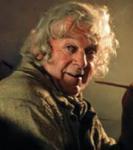 Father
of Samwise Gamgee. Hamfast Gamgee was born in 2926
of the Third Age. His father Hobson was known as
Roper Gamgee. But while Hamfast's older brother Andwise
followed in their father's trade of rope-making, Ham took up with his cousin
Holman Greenhand who was the gardener at
Bag End for Bilbo
Baggins.
Father
of Samwise Gamgee. Hamfast Gamgee was born in 2926
of the Third Age. His father Hobson was known as
Roper Gamgee. But while Hamfast's older brother Andwise
followed in their father's trade of rope-making, Ham took up with his cousin
Holman Greenhand who was the gardener at
Bag End for Bilbo
Baggins.
Hamfast began working as Holman's apprentice when he was just a lad, and in 2942 he was enlisted to keep people from trespassing in the gardens of Bag End while Bilbo's possessions were being auctioned off. Bilbo had gone off on an adventure and was presumed dead, but to everyone's surprise he returned on June 22. Hamfast saw him ride up on a pony with some big bags and a couple of chests.
Hamfast worked with Holman for about 20 years, and then he was the head gardener at Bag End for 40 years after that. He was accounted a leading authority on root vegetables, particularly potatoes. Hamfast married Bell Goodchild and had six children: Hamson, Halfred, Daisy, May, Samwise, and Marigold. His son Samwise followed in his footsteps and became his apprentice.
Father and son lived at Number 3 Bagshot Row at the bottom of the Hill where Bag End was located. Sam had learned his letters from Bilbo and was fascinated by the old Hobbit's stories, which worried his father somewhat.
"Elves and Dragons! I says to him. Cabbages and potatoes are better for me and you. Don't go getting mixed up in the business of your betters, or you'll land in trouble too big for you, I says to him."By the time of Bilbo's 111th birthday party in 3001, Ham's son Samwise had taken over most of the work. Hamfast, who was now mostly called the Gaffer, had become old and stiff in the joints. When Bilbo left Bag End, he gave the Gaffer some oinment for his joints, a woolen waistcoat, a new spade, and two sacks of potatoes.
The Fellowship of the Ring: "A Long-Expected Party," p. 32
When Frodo sold Bag End to Lobelia Sackville-Baggins in 3018, the Gaffer was quite unhappy, though he was pleased that Sam was going to work for Mr. Frodo Baggins at Crickhollow. On the night of Frodo and Sam's departure, the Gaffer was visited by Khamul, one of the Nazgul, who wanted to know where Baggins had gone. The Gaffer sent him on his way, though he did tell him that Frodo had gone to Buckland. Gandalf visited the Gaffer a week later and learned that Frodo had only recently left.
During the quest, Sam was frequently reminded of his Gaffer's sayings such as, "Where there's life, there's hope and need of vittles." (TTT, p. 309) In the Mirror of Galadriel, Sam saw a vision of the Gaffer being forced out of Bagshot Row. Sam resisted the temptation to go home and remained with Frodo to the end, but when the Hobbits returned to the Shire, Sam discovered that his father had indeed been evicted. Bagshot Row had been turned into a quarry and the Gaffer was living in one of the shacks put up by the ruffians who had taken over the Shire. Farmer Cotton had made sure that the Gaffer had enough to eat, so he was better off than some.
The Gaffer was reunited with his son. He scolded Frodo for selling Bag End and starting all the trouble in the Shire, and then wanted to know whether Sam had performed his job in a satisfactory manner. Frodo replied that Sam was now considered one of the heroes of Middle-earth, to his father's bemusement.
"It takes a lot o' believing," said the gaffer, "though I can see he's been mixing in strange company. What's come of his weskit? I don't hold with wearing ironmongery, whether it wears well or no."When Bagshot Row was restored, the Gaffer moved back into Number 3. After Sam and Rosie moved to Bag End, the Gaffer was looked after by Widow Rumble. He lived to see his son Sam elected Mayor of Michel Delving. Hamfast died in the year 7 of the Fourth Age.
The Return of the King: "The Scouring of the Shire," p. 294
Hamfast is from the Old English
hámfoest
meaning "stay-at-home."
Appendix
F of The Lord of the Rings: "The Languages and Peoples of the Third
Age," p. 414
Gamgee is an English surname
and also a name for "cotton-wool," named after an English surgeon who invented
"Gamgee tissue." Tolkien remembered the name from his childhood near Birmingham
and used it to relate the Gamgee family to the Cotton family. As a Hobbit
name, Gamgee is derived from Gamwich,
a village in the Shire where the family originated. The Hobbitish form
of Gamwich is Galabas - meaning "game village" - rendered
as Galbasi as a family name. Other forms of the family name include
Gammidge, Gamwichy, and Gammidgy.
"Nomenclature
of The Lord of the Rings," entry for Gamgee
The Letters
of J.R.R. Tolkien: Letters #72, #144, #184
Gaffer means "old man."
Gaffer Gamgee was the name given by Tolkien to an old man that he and his boys encountered while on holiday. The man was prone to gossiping and predicting the weather. The name became part of the family lore. (Letters, #257)
Ranugad Galbasi is the original Hobbit name of Hamfast Gamgee. (Appendix F, p. 414)
Genealogy:
See the Gamgee
family tree below.
Sources:
The Fellowship
of the Ring: "A Long-Expected Party," p. 30-32, 46; "The Mirror of
Galadriel," 378
The Return
of the King: "The Scouring of the Shire," p. 291-94; "The Grey Havens,"
p. 302, 304
Appendix
C of The Lord of the Rings: Gamgee genealogy, p. 383
Appendix
F of The Lord of the Rings: "The Languages and Peoples of the Third
Age," p. 414
"Nomenclature
of The Lord of the Rings," entry for Gamgee
Letters
of J.R.R. Tolkien: Letters #72, #144, #184, #257
Names &
Etymology:
Hamfast was named after Sam's father,
Hamfast
Gamgee.
He may also have been called Hamfast Gardner after his father, who became known as Sam Gardner because of his skill at gardening and his role in replanting the Shire after the War of the Ring.
Genealogy:
See the Gamgee
family tree below.
Source:
Appendix
C of The Lord of the Rings: Gamgee genealogy, p. 383
Names &
Etymology:
The name Hamson indicates
that he was the son of Hamfast.
Genealogy:
See the Gamgee
family tree below.
Source:
Appendix
C of The Lord of the Rings: Gamgee genealogy, p. 383
Hobson had four children: Andwise, Hamfast, May, and Halfred. Hobson's eldest son Andwise was a rope-maker too, but his second son Hamfast - father of Sam - became a gardener in Hobbiton. Hobson Gamgee died in 2984.
Names &
Etymology:
The name Hobson indicates
that he was the son of Hob. He was also called Roper Gamgee because
he was a rope-maker. He was the first of the family to be known by the
name Gamgee, which was derived from the town named Gamwich
where the family originated.
Genealogy:
See the Gamgee
family tree below.
Sources:
The Two
Towers: "The Taming of Smeagol," p. 217
Appendix
C of The Lord of the Rings: Gamgee genealogy, p. 383
The Letters
of J.R.R. Tolkien: Letter #144
Genealogy:
See the Gamgee
family tree below.
Source:
Appendix
C of The Lord of the Rings: Gamgee genealogy, p. 383
Genealogy:
See the Gamgee
family tree below.
Source:
Appendix
C of The Lord of the Rings: Gamgee genealogy, p. 383
Names &
Etymology:
Merry Gamgee was named after
Sam's friend, Merry Brandybuck.
He may also have been called Merry Gardner after his father, who became known as Sam Gardner because of his skill at gardening and his role in replanting the Shire after the War of the Ring.
Genealogy:
See the Gamgee
family tree below.
Source:
Appendix
C of The Lord of the Rings: Gamgee genealogy, p. 383
Names &
Etymology:
Pippin Gamgee was named after Pippin
Took.
He may also have been called Pippin Gardner after his father, who became known as Sam Gardner because of his skill at gardening and his role in replanting the Shire after the War of the Ring.
Genealogy:
See the Gamgee
family tree below.
Source:
Appendix
C of The Lord of the Rings: Gamgee genealogy, p. 383
Names &
Etymology:
Primose had a flower name, like
many female Hobbits.
She may also have been called Primrose Gardner after her father, who became known as Sam Gardner because of his skill at gardening and his role in replanting the Shire after the War of the Ring.
Genealogy:
See the Gamgee
family tree below.
Source:
Appendix
C of The Lord of the Rings: Gamgee genealogy, p. 383
Names &
Etymology:
He may also have been called Robin
Gardner after his father, who became known as Sam Gardner because of
his skill at gardening and his role in replanting the Shire after the War
of the Ring.
Genealogy:
See the Gamgee
family tree below.
Source:
Appendix
C of The Lord of the Rings: Gamgee genealogy, p. 383
Rose Cotton Gamgee |
Sarah
McLeod as Rosie in the New Line
film
|
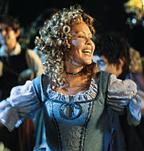 Wife
of Sam Gamgee. Rose Cotton was born in 2984 of the
Third Age to Tolman Cotton and Lily
Brown Cotton. She had four brothers: Tolman (called Tom), Wilcome
(called Jolly),
Bowman (called
Nick), and Carl (called Nibs).
Wife
of Sam Gamgee. Rose Cotton was born in 2984 of the
Third Age to Tolman Cotton and Lily
Brown Cotton. She had four brothers: Tolman (called Tom), Wilcome
(called Jolly),
Bowman (called
Nick), and Carl (called Nibs).
Rosie's father Farmer Cotton had a farm near Bywater down the South Lane. When they were younger, Rosie and her brothers would go swimming with Sam Gamgee in Bywater Pool. Her brother Tom married Sam's sister Marigold.
When Sam left the Shire without warning in September of 3018, most Hobbits thought he was dead. But on March 25, 3019, after the Ring was destroyed and Frodo and Sam were rescued, Rosie felt an inexplicable but certain knowledge that Sam was safe.
"I never hoped at all, Sam," she said, "not until that very day; and then suddenly I did. About noon it was, and I felt so glad that I began singing. And mother said: 'Quiet, lass! There's ruffians about.' And I said: 'Let them come! Their time will soon be over. Sam's coming back.' And you came."She expected Sam to return in the Spring, and she chided him for the delay when he finally returned in November of that year. One of Sam's primary concerns on his return was determining that Rosie was safe. She sent him off to deal with the ruffians but not without reassuring him first. Rosie was proud to hear of Sam's deeds on the quest.
The History of Middle-earth, vol. IX, Sauron Defeated: "Epilogue" (second version), p. 128
When Sam proposed to Rosie, she saw no reason to wait, and they were married on May 1, 3020. They moved into Bag End at the invitation of Frodo. Rosie and Sam's first child was born the next year on March 25, the anniversary of the destruction of the Ring. They named her Elanor after the golden flowers of Lothlorien. Rose bore twelve more children: Frodo Gardner, Rose, Merry, Pippin, Goldilocks, Hamfast, Daisy, Primrose, Bilbo, Ruby, Robin, and Tolman.
When Frodo left Middle-earth in September of 3021, he gave Bag End to Sam and Rosie and their descendants. They lived there peacefully and prosperously for many years. Sam was elected Mayor of Michel Delving and served seven seven-year terms. In the year 21 of the Fourth Age, Rosie accompanied Sam and Elanor to Gondor and stayed there for a year.
On Mid-year's Day in the year 61, Rosie died. Sam then followed Frodo to the Grey Havens and passed over the Sea.
Names &
Etymology:
She may also have taken the name
Rose
Gardner after her husband, who became known as Sam Gardner because
of his skill at gardening and his role in replanting the Shire after the
War
of the Ring.
Genealogy:
See the Gamgee
family tree below.
Sources:
The Return
of the King: "Mount Doom," p. 211; "The Scouring of the Shire," p.
287-88, 294; "The Grey Havens," p. 304-6
Appendix
B of The Lord of the Rings: "The Tale of Years," p. 377-78;
Appendix
C of The Lord of the Rings: Cotton genealogy, p. 383
The History
of Middle-earth, vol. IX, Sauron Defeated: Epilogue (second version),
p. 128
Names &
Etymology:
She may also have been called Rose
Gardner after her father, who became known as Sam Gardner because of
his skill at gardening and his role in replanting the Shire after the War
of the Ring.
Genealogy:
See the Gamgee
family tree below.
Source:
Appendix
C of The Lord of the Rings: Gamgee genealogy, p. 383
Names &
Etymology:
She may also have been called Ruby
Gardner after her father, who became known as Sam Gardner because of
his skill at gardening and his role in replanting the Shire after the War
of the Ring. Ruby was named for a jewel as was common among
female Hobbits.
Genealogy:
See the Gamgee
family tree below.
Source:
Appendix
C of The Lord of the Rings: Gamgee genealogy, p. 383
Names &
Etymology:
Tolman Gamgee was named after
his grandfather, Tolman Cotton.
He may also have been called Tolman Gardner after his father, who became known as Sam Gardner because of his skill at gardening and his role in replanting the Shire after the War of the Ring.
Genealogy:
See the Gamgee
family tree below.
Source:
Appendix
C of The Lord of the Rings: Gamgee genealogy, p. 383
Genealogy:
See the Gamgee
family tree below.
Names &
Etymology:
Hob Gammidge was called the
Roper and Old Gammidgy. His surname Gammidge is a variation
of his father's surname Gamwich, which was the name of the town
where Wiseman Gamwich lived before moving to Tighfield. In the next generation,
Hob Gammidge's son Hobson used the surname Gamgee.
Source:
Appendix
C of The Lord of the Rings: Gamgee genealogy, p. 383
Genealogy:
See the Gamgee
family tree below.
Source:
Appendix
C of The Lord of the Rings: Gamgee genealogy, p. 383
Hamfast of Gamwich's date of death is not known.
Names &
Etymology:
Hamfast is from the Old English
hámfoest
meaning "stay-at-home."
Gamwich was from the Hobbit name Galabas meaning "game village" from the Hobbitish galab meaning "game" and bas, the equivalent of the Old English wick or wich meaning "village." This name later became the surname Gamgee.
Genealogy:
See the Gamgee
family tree below.
Sources:
Appendix
C of The Lord of the Rings: Gamgee genealogy, p. 383
Appendix
F of The Lord of the Rings: "The Languages and Peoples of the Third
Age," p. 414, 416
The Letters
of J.R.R. Tolkien: Letter #144
Names &
Etymology:
Wiseman's first name appears
to echo the name Samwise, or "half wise." His surname is the name
of his village of origin. Gamwich was from the Hobbit name Galabas
meaning "game village" from the Hobbitish galab meaning "game" and
bas,
the equivalent of the Old English wick or wich meaning "village."
Genealogy:
See the Gamgee
family tree below.
Sources:
Appendix
C of The Lord of the Rings: Gamgee genealogy, p. 383
Appendix
F of The Lord of the Rings: "The Languages and Peoples of the Third
Age," p. 416
The Letters
of J.R.R. Tolkien: Letter #144
Frodo GardnerSon of Sam Gamgee. Frodo Gamgee, born in the year 2 of the Fourth Age, was the second child and eldest son of Sam and Rose Cotton Gamgee. He had an older sister Elanor and eleven younger siblings: Rose, Merry, Pippin, Goldilocks, Hamfast, Daisy, Primrose, Bilbo, Ruby, Robin, and Tolman.Sam Gamgee came to be known as Sam Gardner because of his skill at gardening and his role in replanting the Shire after the War of the Ring. His son Frodo took Gardner as his family name. Frodo Gardner probably inherited Bag End after his father left Middle-earth in the year 61. From Frodo were descended the Gardners of the Hill including his son Holfast Gardner, born in 41 F.A., and his grandson Harding of the Hill. Genealogy:
Sources:
|
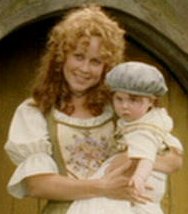 |
Genealogy:
See the Gamgee
family tree below.
Names &
Etymology:
Also called Harding of the Hill
because he lived on the Hill in Hobbiton.
It seems likely that Bag End was passed
down to Harding through Holfast from Sam's eldest son Frodo.
The name Harding means "son of the bold one" from the Old English heard meaning "bold, hardy" and the ending -ing denoting "son of."
Sources:
Appendix
C of The Lord of the Rings: Gamgee genealogy, p. 383
Old English
Genealogy:
See the Gamgee
family tree below.
Source:
Appendix
C of The Lord of the Rings: Gamgee genealogy, p. 383
Halfred had a son named Holman Greenhand who worked as a gardener for Bilbo Baggins at Bag End.
Names &
Etymology:
The name Greenhand is a reference
to gardening.
Genealogy:
See the Gamgee
family tree below.
Source:
Appendix
C of The Lord of the Rings: Gamgee genealogy, p. 383
Holman Greenhand worked in the garden at Bag End in Hobbiton. Holman liked and admired Bilbo Baggins but found his employer's tendency to wander off on his own and talk to strangers and travellers rather peculiar. On April 5, 2941, Bilbo went out walking and told Holman that he hoped to meet some Elves since the next day was the Elves' New Year.
Shortly thereafter, Gandalf came to Bag End looking for Bilbo and Holman told the Wizard what Bilbo had said before he left. Gandalf was pleased by this indication of Bilbo's adventurous spirit and he made up his mind to include Bilbo as a member of the quest to reclaim the Lonely Mountainfrom Smaug the Dragon.
When over a year had passed since Bilbo left on the quest, he was declared dead. An auction was held to sell his possessions on June 22, 2942, and Holman assigned his apprentice Hamfast Gamgee to keep people from trampling the garden. Bilbo returned in the middle of the auction and took up residence in Bag End once more. Holman continued to work for Bilbo until around 2961, when Hamfast took over as gardener at Bag End. Holman's date of death is not known.
Names &
Etymology:
The name Greenhand is a reference
to gardening, while the name Holman may imply "hole dweller."
Genealogy:
See the Gamgee
family tree below.
Sources:
The Fellowship
of the Ring: "A Long-Expected Party," p. 30, 32
Appendix
C of The Lord of the Rings:
Gamgee genealogy, p. 383
Unfinished
Tales: "The Quest for Erebor," p. 323, 327
The History
of Middle-earth, vol. XII, The Peoples of Middle-earth: "The Family
Trees," p. 113
Names &
Etymology:
The name Holman probably
means "hole dweller." His eldest son and his descendants took the surname
Greenhand
because they were gardeners.
Genealogy:
See the Gamgee
family tree below.
Source:
Appendix
C of The Lord of the Rings: Gamgee genealogy, p. 383
Genealogy:
See the Gamgee
family tree below.
Source:
Appendix
C of The Lord of the Rings: Gamgee genealogy, p. 383
Andwise was commonly called Andy. He was a rope-maker like his father. They had a rope-maker's yard known as a rope-walk in the village of Tighfield. Sam Gamgee's older brother Hamson went to work for Andy as a rope-maker, and Sam learned quite a bit about ropes and knots from his Uncle Andy as well.
Genealogy:
See the Gamgee
family tree below.
Sources:
The Fellowship
of the Ring: "Lothlorien," p. 361
The Two
Towers: "The Taming of Smeagol," p. 217
Appendix
C of The Lord of the Rings: Gamgee genealogy, p. 383
"Nomenclature
of The Lord of the Rings," entry for Tighfield
Genealogy:
See the Gamgee
family tree below.
Source:
Appendix
C of The Lord of the Rings: Gamgee genealogy, p. 383
Genealogy:
See the Gamgee
family tree below.
Source:
Appendix
C of The Lord of the Rings: Gamgee genealogy, p. 383
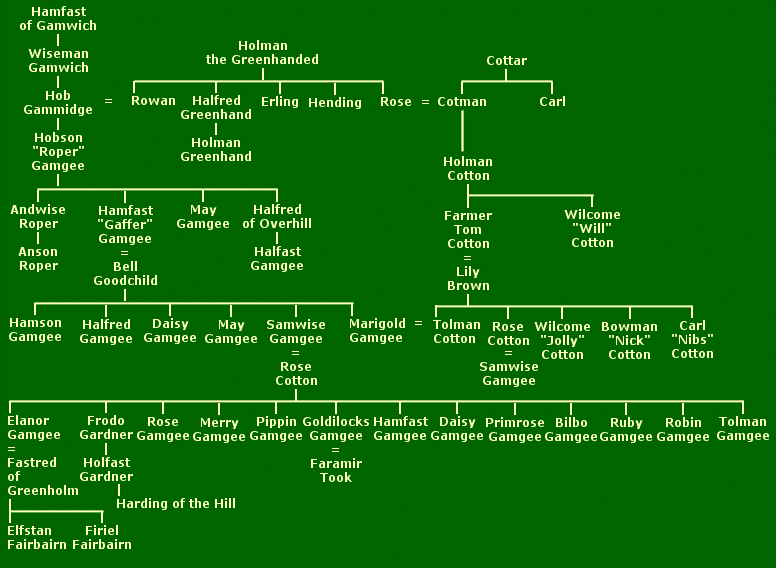
All entries are Copyright © by the Thain from former tuckborough.net. Please contact me if you are Thain or know anything about how to contact the original author.
2003-2011, The Thain's Book - thainsbook.minastirith.cz
- e-mail: thain at tuckborough.net